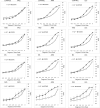Characteristics of sensitization associated with chronic pain conditions
- PMID: 23629594
- PMCID: PMC4389646
- DOI: 10.1097/AJP.0b013e318287aac7
Characteristics of sensitization associated with chronic pain conditions
Abstract
Objectives: To describe and understand varieties and characteristics of sensitization contributing to hyperalgesia in participants with chronic pain conditions.
Methods: Thermal stimulation was delivered to the face, forearm, and calf of pain-free participants and individuals with irritable bowel syndrome, temporomandibular pain disorder (TMD), and fibromyalgia syndrome (FM). Three-second contacts by a preheated thermode occurred at 30-second intervals in ascending and then in descending series (0.7°C steps).
Results: Thermal pain ratings during ascending series were greater at each site in individuals diagnosed with chronic pain. Intense pain at the time of testing further enhanced the ratings at all sites, but mild or moderate clinical pain did not have this effect. Thermal pain in all participants was greater during descending series compared with the ascending series of arm and leg stimulation. The hypersensitivity during the descending series was comparable in pain-free, FM and TMD participants but was increased in duration for arm or leg stimulation of FM participants.
Discussion: The widespread sensitization for irritable bowel syndrome and TMD participants does not rely on mechanisms of spatial and temporal summation often invoked to explain widespread hyperalgesia associated with chronic pain. Increased sensitivity during descending series of stimulation of an arm or leg but not the face indicates a propensity for sensitization of nociceptive input to the spinal cord. Abnormally prolonged sensitization for FM participants reveals a unique influence of widespread chronic pain referred to deep somatic tissues.
Figures





Similar articles
-
Effects of the N-methyl-D-aspartate receptor antagonist dextromethorphan on temporal summation of pain are similar in fibromyalgia patients and normal control subjects.J Pain. 2005 May;6(5):323-32. doi: 10.1016/j.jpain.2005.01.357. J Pain. 2005. PMID: 15890634 Clinical Trial.
-
Thermal and visceral hypersensitivity in irritable bowel syndrome patients with and without fibromyalgia.Clin J Pain. 2007 May;23(4):323-30. doi: 10.1097/AJP.0b013e318032e496. Clin J Pain. 2007. PMID: 17449993 Clinical Trial.
-
Hypersensitivity to cutaneous thermal nociceptive stimuli in irritable bowel syndrome.Pain. 2005 May;115(1-2):5-11. doi: 10.1016/j.pain.2005.01.023. Pain. 2005. PMID: 15836964 Clinical Trial.
-
Is it all central sensitization? Role of peripheral tissue nociception in chronic musculoskeletal pain.Curr Rheumatol Rep. 2010 Dec;12(6):448-54. doi: 10.1007/s11926-010-0134-x. Curr Rheumatol Rep. 2010. PMID: 20882373 Review.
-
Mechanisms underlying development of spatially distributed chronic pain (fibromyalgia).Pain. 2006 Oct;124(3):242-263. doi: 10.1016/j.pain.2006.06.001. Epub 2006 Jul 13. Pain. 2006. PMID: 16842915 Review.
Cited by
-
Risk for irritable bowel syndrome in fibromyalgia patients: a national database study.Medicine (Baltimore). 2015 Mar;94(10):e616. doi: 10.1097/MD.0000000000000616. Medicine (Baltimore). 2015. PMID: 25761187 Free PMC article.
-
Pharmacological validation of a novel nonhuman primate measure of thermal responsivity with utility for predicting analgesic effects.J Pain Res. 2018 Apr 11;11:735-741. doi: 10.2147/JPR.S152879. eCollection 2018. J Pain Res. 2018. PMID: 29692626 Free PMC article.
-
Increased Risk of Stroke in Patients With Fibromyalgia: A Population-BASED Cohort Study.Medicine (Baltimore). 2016 Feb;95(8):e2860. doi: 10.1097/MD.0000000000002860. Medicine (Baltimore). 2016. PMID: 26937918 Free PMC article.
-
A afferent fibers are involved in the pathology of central changes in the spinal dorsal horn associated with myofascial trigger spots in rats.Exp Brain Res. 2015 Nov;233(11):3133-43. doi: 10.1007/s00221-015-4382-x. Epub 2015 Jul 26. Exp Brain Res. 2015. PMID: 26210690
-
Analgesia and peripheral c-fiber modulation by selective Na v 1.8 inhibition in rhesus.Pain. 2025 Mar 1;166(3):631-643. doi: 10.1097/j.pain.0000000000003404. Epub 2024 Oct 8. Pain. 2025. PMID: 39382325 Free PMC article.
References
-
- Moshiree B, Price DD, Robinson ME, Gaible R, Verne GN. Thermal and visceral hypersensitivity in irritable bowel syndrome patients with and without fibromyalgia. Clin J Pain. 2007;23:323–30. - PubMed
-
- Piche M, Arsenault M, Poitras P, Rainville P, Bouin M. Widespread hypersensitivity is related to altered pain inhibition processes in irritable bowel syndrome. Pain. 2010;148:49–58. - PubMed
-
- Rodrigues AC, Nicholas VG, Schmidt S, Mauderli AP. Hypersensitivity to cutaneous thermal nociceptive stimuli in irritable bowel syndrome. Pain. 2005;115:5–11. - PubMed
Publication types
MeSH terms
Grants and funding
LinkOut - more resources
Full Text Sources
Other Literature Sources
Medical

